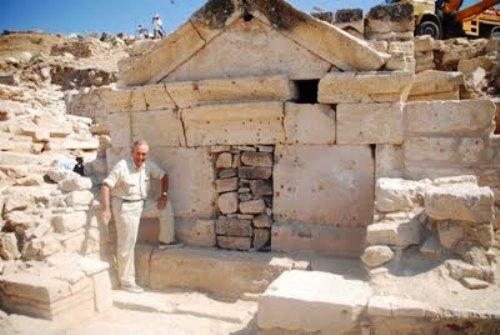Turquie: des archéologues auraient découvert la tombe de l'apôtre Philippe
Source - http://www.leparisien.fr/flash-actualite-culture/turquie-des-archeologues-auraient-decouvert-la-tombe-de-l-apotre-philippe-27-07-2011-1546842.php
Une équipe d'archéologues dirigée par l'Italien Francesco d'Andria a affirmé avoir retrouvé à Pamukkale, l'antique Hiérapolis, dans l'ouest de la Turquie, la tombe de Saint Philippe, l'un des douze apôtres de Jésus Christ, rapporte l'agence Anatolie.

"Nous tentons de retrouver depuis des années la tombe de Saint Philippe (...) Nous l'avons finalement trouvée dans les décombres d'une église (de la zone) que nous avons mis au jour il y a un mois", a souligné l'archéologue qui travaille depuis plusieurs années en Turquie, cité par l'agence.

[Credit: DHA]
Il a précisé que la tombe n'avait pas encore été ouverte.
"Un jour elle le sera sans doute. Cette découverte est d'importance majeure pour l'archéologie et le monde chrétien", s'est félicité l'archéologue.
Originaire de Galilée, l'actuel Israël, Philippe fut l'un des disciples du Christ. Il serait parti évangéliser des régions d'Asie Mineure et aurait été lapidé puis crucifié par les Romains à Hiérapolis, en Phrygie.
L'actuelle Pamukkale est un site touristique connu surtout pour ses eaux thermales et ses roches sédimentaires, les travertins blancs, d'où son nom qui signifie "château de coton" en turc.

Apostle Philip's tomb found in Turkey? Maybe not
Sean McLachlan
The news wires are humming with yet another spectacular archaeological discovery, this time of the tomb of the Apostle Philip.
St. Philip was one of Christ's twelve apostles and is said to have been martyred and buried in Hierapolis, now Pamukkale in southwestern Turkey. The city was an ancient spa town owing to the local hot springs and also a center for pagan temples. St. Philip is said to have come here to preach Christianity.

Italian archaeologist Francesco D'Andria and his team believe they have discovered his tomb. The description of the tomb and the writings they found on it all match up to it being St. Philip's burial place, they say.
But this might be more media frenzy and wishful thinking than a real discovery, along the lines of the recent "discoveries" of Caligula's tomb and the Crucifixion nails. First off, the Catholic Encyclopedia casts doubt on whether Philip the Apostle was buried in Hierapolis at all. The Catholic Church doesn't recognize the tradition of his being martyred in Hierapolis because it comes from the Acts of Philip, a source written centuries after Philip's death. Also, the tomb hasn't been opened, making it hard to say anything definitive. None of the news reports I read go into detail about what inscriptions the archaeologists found.
I'm not questioning the archaeologists' techniques or credibility, merely complaining about bad reporting. Perhaps D'Andria did talk to reporters about the inscriptions he found, but none of them covered that. Indeed, all of them state as fact that Philip the Apostle was buried in Hierapolis, and many state as fact that this is Philip's tomb. As happens so often with news stories about archaeology, reporters leap to attractive conclusions without checking their facts.
Hopefully D'Andria and his team really did find Philip the Apostle's tomb. This will add yet another reason to visit Hierapolis, which is already a UNESCO World Heritage Site. From the quickie news reports, though, it's hard to say for sure.